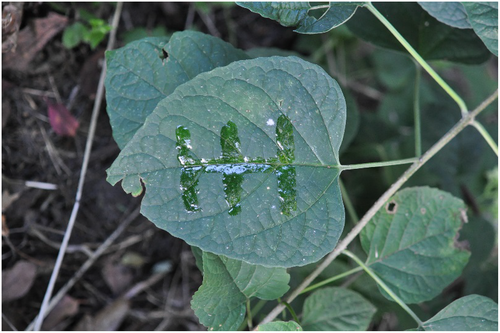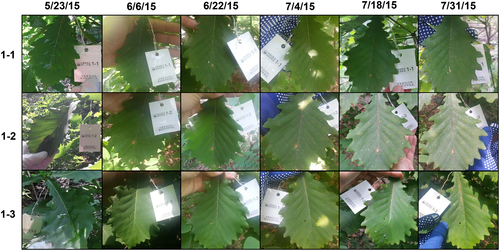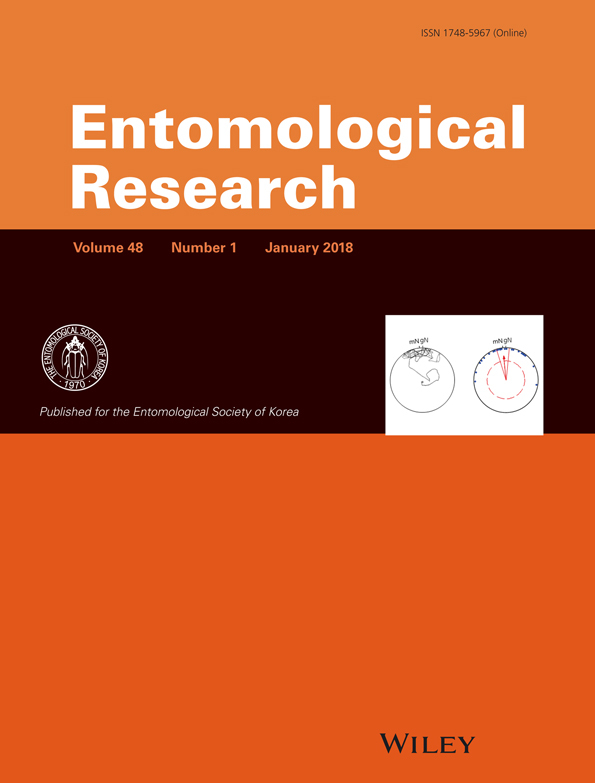Validation of 走肖爲王: Can insects write letters on leaves?
Abstract
The Annals of the Joseon Dynasty report that large-scale reformations undertaken by Jungjong, 11th king of the Joseon dynasty, were stopped after Kwang-Jo Cho was slandered and subsequently executed. Reportedly, a party opposing the reformations wrote a phrase “走肖爲王” on a leaf in the palace by using sugary water; subsequently, insects ingested the sugary parts of leaf and the phrase was left behind. The phrase “走肖爲王” means “Cho will become king” and Jungjong accepted the phrase as a warning sign from heaven that Cho was attempting a coup d'état. Although there are several historical records that report such insect writing, it has not been determined whether creating a phrase on a leaf by using insects is possible. In a field study conducted on Gwanak Mountain, Korea, we tested whether writing letters on leaves by insects is possible. The results showed no sign of selective insect ingestion creating the form of a letter on a leaf after sugary water was applied. There is a high possibility that 走肖爲王 incident was fictional; particularly when considering the complexity of the phrase and the life history and behavior of insects.
Introduction
Jungjong (ad 1488–1544), 11th king of the Joseon dynasty, rose to the throne with a coup d'état against Yeonsangun, the step brother of Jungjong. Once he became king, Jungjong started to undertake large-scale reformations with the help of Kwang-Jo Cho. However, the reformations were opposed by many conservative nobles and they tried to eliminate Cho, who was leading the reformations. Several historic records describe that Gon Nam, one of the conservative nobles, set out to slander Cho. The records also indicate that Nam wrote a phrase “走肖爲王” on a leaf in the palace by using sugary water. The intention was that insects would only ingest the sugary parts of the leaf and the phrase would be left behind once the insects were finished eating. When the two Chinese letters, 走 (Ju) and 肖(Cho) are combined, it can be read as 趙 (Cho), Kwang-Jo's last name. The Chinese letters 爲 (We) and 王 (Wang) mean “for” and “king”, respectively. The phrase is thus interpreted as “Cho will become king”. Groups of conservative nobles brought the leaf to Jungjong and claimed that it was a warning sign from heaven that Cho is preparing to mount a coup d'état. In response, Jungjong executed Kwang-Jo Cho on a charge of treason in 1519, and this incident is referred to as the Gimyo massacre of scholars.
Although it is well accepted that the phrase 走肖爲王 provided the rationale for the Gimyo massacre of scholars, it has not been determined whether the actual writing of the phrase on a leaf by insects is possible. Therefore, we conducted a field study to see whether writing the phrase by using insects could be reproduced. Two questions –“Was writing the phrase by insects a historical fact?”, and if it is, “Which insects fed on the sugary water leaving holes behind?”– can be answered by the results of this study. Those results are important from both historical and scientific points of view.
Materials and methods
Study site
Gwanak Mountain, Korea, was chosen as the study site for two reasons. First, it is located in the Seoul area at a similar latitude and longitude as the palaces of the Joseon dynasty. Second, the area was part of the Gwanak Mountain ecological and scenery conservation area created in 2009 and the flora and fauna of the area were already described. It has been reported that there are 107 insect species within 49 insect families and 136 plant species within 58 plant families in the Gwanak Mountain area (Oh 2012).
Selection of plants and marking of leaves
It was not possible to write letters on all plant species due to the waxy cuticles of leaves of some species. Forty plants were chosen to write letters on leaves (Table 1). All chosen plants were at least 20 m away from a trail to eliminate possible human intervention. Representative leaves and digital images of the chosen plants were brought to Inha University for species identification. A 10 % honey solution was chosen for writing letters on leaves after performing preliminary experiments. Solutions lower or higher than 10 % honey were either too watery or too sticky to write letters on leaves. Honey was chosen because several historical records, including the Annals of the Joseon Dynasty, indicate that Nam wrote letters with a honey solution; although some records indicate that Nam wrote letters with extracts of sweet fruits. In our study, marking on leaves was done on the underside of the leaves to eliminate the possible washing off of sugary water by rainfall. Instead of writing the whole phrase, only the letter 王 (Wang) was written on the leaves by using a brush (Fig. 1). Marking was done on at least three leaves of each plant. The first marking was done on 9 May 2015, and leaf damage was checked every two weeks thereafter. New markings were performed until 31 July 2015. The total amount of rainfall during the study period was approximately 345 mm (data from Korean Meteorological Administration; May, 24.9 mm; June, 99 mm; July, 221 mm).
| No. | Species | No. | Species |
|---|---|---|---|
| 1 | Quercus mongolica | 21 | Quercus variabilis |
| 2 | Quercus serrata | 22 | Quercus serrata |
| 3 | U.D.† | 23 | Rubus crataegifolius |
| 4 | Corylus heterophylla | 24 | Rhus trichocarpa |
| 5 | U.D. | 25 | Rhododendron yedoense |
| 6 | U.D. | 26 | Corylus heterophylla |
| 7 | Quercus acutissima | 27 | Ginkgo biloba |
| 8 | Prunus persica | 28 | Fraxinus rhynchophylla |
| 9 | Rhododendron schlippenbachii | 29 | U.D. |
| 10 | Stephanandra indica | 30 | Quercus mongolica |
| 11 | Rhododendron mucronulatum | 31 | Rhododendron schlippenbachii |
| 12 | Styrax japonicus | 32 | Quercus serrata |
| 13 | U.D. | 33 | U.D. |
| 14 | Smilax sieboldii | 34 | U.D. |
| 15 | Rubus crataegifolius | 35 | Robinia pseudoacacia |
| 16 | Viburnum erosum | 36 | Smilax sieboldii |
| 17 | Rhododendron mucronulatum | 37 | Rhododendron schlippenbachii |
| 18 | Smilax nipponica | 38 | Quercus serrata |
| 19 | Quercus mongolica | 39 | Rhododendron mucronulatum |
| 20 | Sorbus alnifolia | 40 | Quercus mongolica |
- † Unidentifiable

Results and Discussion
Among the 40 marked plants, there were 20 different plant species and 7 plants for which the species was undetermined (Table 1). During the field research period (5/9/2015–7/31/2015), no marked letter relevant leaf damage was detected. Some damage did occur, but the damage was not relevant to the marked letter (Fig. 2). Therefore, we failed to replicate the writing of letters on leaves by insects.

There are four main steps in the feeding process of phytophagous insects: orientation, arrest, initiation of feeding, and maintenance of feeding. The chemicals involved in each of those steps are attractant, arrestant, incitant, and stimulant, respectively (Matsuda 1988). Honey can stimulate all of those feeding steps in phytophagous insects. When various attractants were tested, a honey extract attracted more mosquitoes than carbon dioxide (Kline et al. 1990). Sugary resources are the most abundant resource for insects, and many insects are attracted to sugary resources since carbohydrates provide nutrients and regulate feeding behavior. For example, glucose, fructose, and sucrose are largely consumed by the majority of ants (Völkl et al. 1999; Blüthgen and Fiedler 2004), and glucose, fructose, and sucrose act as feeding incitants and stimulants (Rockstein 1978; Nation 2002). Glucose and fructose are the major components of honey. Based on those results, it seems appropriate for Nam to write letters with a honey solution or an extract of sweet fruits.
Although we could not replicate the writing of letters on leaves by insects, it does not directly mean that the 走肖爲王 incident was not a historical event. Present-day usage of pesticides can significantly reduce insect abundance (Jaganmohan et al. 2013), and failure to replicate the 走肖爲王 incident could be due to differences in insect abundance. Insect abundance may have been greater during the Joseon dynasty due to an absence of pesticide use in that era. In the Annals of the Joseon Dynasty, there were 261 records of pest outbreaks and they were reported to be stressful to both the king and the general public (Park et al. 2010). Although we cannot fully exclude the possibility that insect abundance was greater in Joseon dynasty and that Nam wrote letters by using insects, the chance of the latter is quite low for several reasons. First, Nam definitely needed leaves with insect damage that was representative of 走肖爲王 to show to King Jungjong. Nam may not have been sure that the phrase could be made by insects; thus, it may have been safer for him to make letters on leaves with other methods, such as by using a needle. Second, Nam needed four letters written on the leaf. The four letters are made up of 30 strokes that are hard to write legibly on leaves. In particular, 爲 is made up of 12 strokes and needs a large size leaf to be legible. In our field site, there were no trees with large leaves. Third, the life history of insects should be considered. Insects with complete metamorphosis damage crops mainly in the adult stage, while insect with incomplete metamorphosis damage crops mainly in larval stage. There is no historical information on when the letters were written on leaves, but considering the life history of most insects, writing letters on leaves by adult or larval insects is not possible throughout the year. Moreover, during a year, the active feeding stage of most insects is relatively short. For example, it takes tobacco hornworm, Manduca sexta 18 days for first instar larvae to develop pupae at 25°C (Reinecke et al. 1980). In most areas, M. sexta has two generations per year (bivoltine), resulting in a period of active feeding of just 36 days. Therefore, there may be only 1–2 months in a year when it is possible for insects to write letters on leaves.
Injury to foliage can be caused by several causes including physical damage such as sunburn, plant diseases such as virus or fungi, arthropod pests, and animals such as snails and vertebrates. Most damage to plants caused by insects is a result of direct feeding on plant parts and the type of feeding damage caused by insects is related to the type of mouthparts of the insect (Cranshaw 2004; Pedigo and Rice 2006), which can be classified as chewing, siphoning, and piercing or sucking. Among those, chewing is the only feeding pattern that could write letters on leaves. Caterpillars, grasshoppers, and beetles have chewing mouthparts consisting of two opposing mandibles. The damage by chewing insects includes holes in leaves, leaf skeletonization, leaf defoliation, and mining in leaves. Many holes in leaves caused by insect damage may be interpreted as a letter or phrase, but the chance of insects creating 走肖爲王 is quite low.
In conclusion, we were unable to reproduce the writing of letters on leaves by insects and there is a high possibility that the 走肖爲王 incident was fictional, particularly when considering complexity of the phrase and the life history of insects.
Acknowledgment
This work was supported by Inha University.




